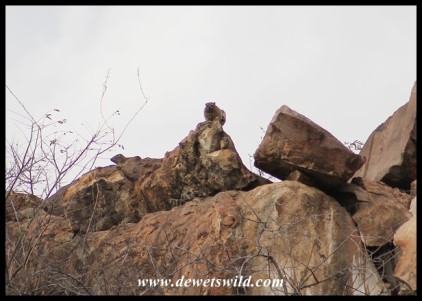A fact that is not well-known, even among South Africans, is that our country is home to two different kinds of Dassie, or Hyrax, that live mainly in rocky terrain. We’ve already featured the species most people are acquainted with, the Rock Dassie (Procavia capensis), which is widely distributed throughout all our provinces. By contrast, in this country the Yellow-spotted Rock Dassie occurs only in our northernmost province, Limpopo, and often in mixed communities of both species numbering from a few to more than a hundred. The rugged Mapungubwe National Park is an excellent place to see them.
Heterohyrax brucei
Like their better known relatives, Yellow-spotted Rock Dassies are herbivores that feed on a wide variety of plant material, with leaves forming the bulk of their diet. They are fairly independent of drinking water. Yellow-spotted Rock Dassies are also diurnal and love basking in the sun. They’re excellent at climbing around in trees, which they do mostly for feeding as they’d usually take cover among the rocks in case of danger. One of the group is always on sentry duty while the rest feed.
The basic social unit of a colony of Yellow-spotted Rock Dassies consist of a dominant, territorial male with a harem of adult females and their young. They breed throughout the year, females usually giving birth to 2 babies. Adult Yellow-spotted Rock Dassies weigh between 1.5kg and 3.5kg and measure between 30cm and 50cm in length. They seldom live to older than 11 years in the wild, and usually much shorter.
With its distribution extending northwards well beyond Limpopo Province all the way to Sudan, the IUCN considers the Yellow-spotted Rock Hyrax to be of least concern.

Yellow-spotted (left) and Rock Dassie (right) sharing the sun in Mapungubwe






















Another animal that is new to me. They say that these dassies are distantly related to elephants!
LikeLike
Isn’t that amazing, Hien!?
LikeLike
Great captures!
LikeLike
Thanks, Sue!
LikeLiked by 1 person
😊😊
LikeLiked by 1 person
Ek wil ook se dit lyk kompleet of daar ‘n glimlaggie op hulle gesiggies is. Ek is altyd verbaas om te sien hoe rats hulle tussen die rotse is (dis dan waarskynlik eerder die “rock dassies” wat ons gewoonlik sien, ne).
LikeLiked by 1 person
Jip, in ons land is dit net wanneer mens in Limpopo reis wat jy moet onthou dat daar meer as een soort klipdassie voorkom
LikeLiked by 1 person
Ag hulle is darem te oulik! Ek is nie seker of die dieselfde spesie is wat hier by ons voorkom nie, maar ek sien hulle gewoonlik as ons gaan stap!
LikeLiked by 1 person
Die by julle sal die “gewone” klipdassie wees, Aletta. By ons kom hierdie soort net in die Limpopo Provinsie voor.
LikeLike
Dankie Dries, het gewonder.
LikeLiked by 1 person
I am so pleased to have made its acquaintance through your photographs for I haven’t come across one before. The photograph of the two together shows off the differences between them very well.
LikeLiked by 1 person
Thank you, Anne. Mapungubwe is a great place to find them.
LikeLike
I love those little faces that almost look as it they are looking at the photographer.
LikeLiked by 1 person
They are very co-operative models!
LikeLike
Kinda cute with that little smile on their face!
LikeLiked by 1 person
The friendly face and plump bodies make for a cute package!
LikeLiked by 1 person